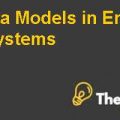
Ans. 1a) Mean: Mean is the average of two or more numbers. It can be calculated in many ways which includes arithmetic mean and by method of geometric mean.
Ans. 1b) Standard Deviation: The purpose of using Standard deviation is to measure volatility in an investment return.
Ans. 2) Argument in favor of diversifying is that it has low chances to deviate as compare to the IBM standard deviation. IBM standard deviation is around 9.4%, whereas the average monthly standard deviation of Investment plan offer by VIP is 2.76%
On the other hand it can be argued that though Investment mix is having low standard deviation, but at the same time it is generating a low return as compare to IBM monthly return.
IBM is generating an average monthly return of 1.27%, whereas the investment plan offer by VIP is generating only 0.67%.
IBM will not be in favor of such Investment plan because if their investment volatiles by the standard deviation rate, they will still generate more return then the VIP Investment plan.
Ans. 3) At target standard deviation of 10% the investment plan will generate an average annual return of 8.9% where the Investment mix will be 49% of S&P 500, 43% of MSCI World and 8% of Lehman Brothers Bond. It has an inverse relation with Standard deviation. The more the Standard deviation the lesser will be the Return on Investment.
Ans. 4a) At target standard deviation of 2% the investment plan will generate an average annual return of 6.4% where the Investment mix will be 5% of S&P 500, 5% of MSCI World and 90% of Lehman Brothers Bond.
Ans. 4b) At target standard deviation of 20% the investment plan will generate an average annual return of 8.8% where the Investment mix will be 100% of MSCI World
Ans. 4c) At target standard deviation of 14% the investment plan will generate an average annual return of 8.9% where the Investment mix will be the 8% of S&P 500 and 92% of MSCI World
Ans. 4d.) At target standard deviation of 6% the investment plan will generate an average annual return of 7.7% where the Investment mix will be 28% of S&P 500, 25% of MSCI World and 47% of Lehman Brothers Bond.
Ans. 5.1) from the graph prepared to present IBM, it can be said that though, IBM is generating annual returns of 15%, at the same time IBM has a high standard deviation of around 32%. Now if IBM investment volatile with 32% than IBM will get a return of around 10.2%. Which is (15%/32%) -1 = around 53% reduction in return if the investment got riskier and deviate from its plan. Where as in contract VIP’s Investment plan is less risky, as if their Investment Plan deviates from the expectation they will (9%/10%) -1 = lose around 10% of the expected return which is far better than the IBM’s Investment in Stock.
Ans. 5.2) from the graph prepared to present IBM, it can be said that though, IBM is generating annual returns of 15%, at the same time IBM has a high standard deviation of around 32%. Now if IBM investment volatile with 32%, then IBM will get a return of around 10.2%. Which is (15%/32%) -1 = around 53% reduction in return if the investment got riskier and deviates from its plan. Where as in contract VIP’s Investment plan is less risky, as if their Investment Plan deviate from the expectation they will not lose more as here it is showing inverse relation in favor of Investment.
Ans. 5.3) from the graph prepared to present IBM, it can be said that, IBM is generating annual returns of 15%, at the same time IBM has a high standard deviation of around 32%. Now if IBM investment volatile with 32% then IBM will get a return of around 10.2%. Which is (15%/32%) -1 = around 53% reduction in return if the investment got riskier and deviates from its plan. Where as in contract VIP’s Investment plan is less risky, as if their Investment Plan deviates from the expectation they will (8.84%/15.11%) -1 = lose around 41.50% of the expected return which is far better than the IBM’s Investment in Stock.
Ans. 5.4) from the graph prepared to present IBM, it can be said that, IBM is generating annual returns of 15%, at the same time IBM has a high standard deviation of around 32%. Now if IBM investment volatile with 32% than IBM will get a return of around 10.2%. Which is (15%/32%) -1 = around 53% reduction in return if the investment got riskier and deviates from its plan...................
This is just a sample partial case solution. Please place the order on the website to order your own originally done case solution.
This technical note provides a simple, yet powerful, optimization exercises to demonstrate the benefits of portfolio diversification and the importance of asset allocation. Although the note is intended for students of MBA course in investment or portfolio management, it is also suitable for advanced undergraduate course. "Hide
by Richard B. Evans 14 pages. Publication Date: August 25, 2009. Prod. #: UV2558-PDF-ENG













